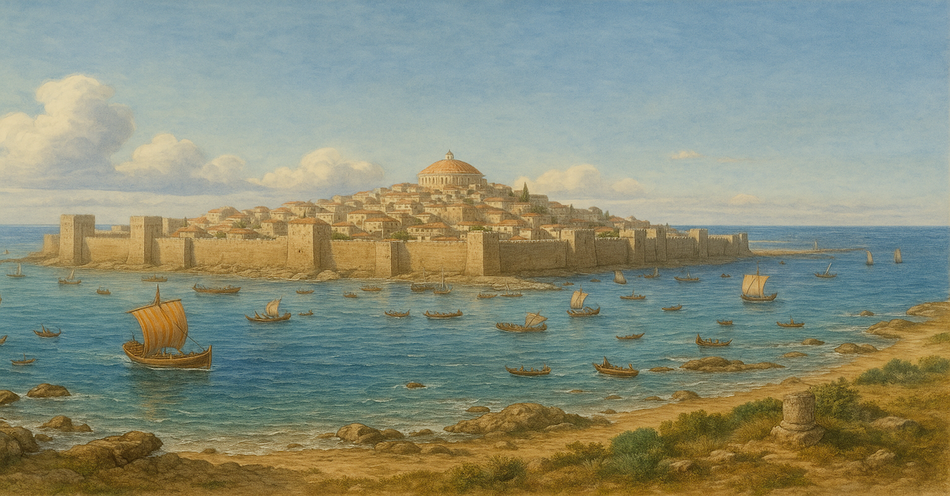Tyre is one of the oldest settlements in the world, with archeological evidence that it was occupied as early as 2700 B.C.E. and references to it in the Old Testament. The original Canaanites living in the coastal area of the Mediterranean Sea survived to become Phoenicians, living in the city-state of Tyre (pronounced “tire”) in the first century B.C.E. The city prospered as a leading center of ship navigation and robust commerce, founding colonies for trade in the Mediterranean and enjoying a rich culture. It’s king assisted Solomon in building the temple in Jerusalem, yet Bible prophets warned of its demise because of Tyre’s arrogance and cruelty in the ancient world. Let's look more into the history and significance of this biblical city below.
Where Was Tyre Located?
Old Tyre was built on the east coast of the Mediterranean, in what is now southern Lebanon, a small country wedged between Israel, Syria, and Jordan. Ancient Tyrians built a second settlement on an island half a mile from the mainland. The two parts of the city lie on rocky terrain.
The rough terrain of the island of Tyre was considered impenetrable by attacking forces; however, an army of Alexander the Great destroyed the mainland portion of Tyre in the 4th century B.C.E. and used stones from the ruins to build a large causeway to the island. The 2600-foot-long by 800-foot-wide causeway connected the two settlements of Tyre.
What Do We Know about Modern-Day Tyre?
In its long history, Tyre was overtaken by other civilizations, notably Assyrian, Babylonian, Egyptian, Greek, and Roman. After centuries of foreign occupation, Tyre was destroyed by the Saracens, Muslim foes of Christians, during the Crusades of the 13th century A.D. The city remained uninhabited for the next 300 years.
Tyre repopulated itself in modern times as a poor fishing village. The causeway that connects old Tyre on the mainland to its island now extends nearly to the width of the island due to sand and silt deposits. It has grown from an estimated 200 people in the late 19th century to an estimated current population of 135,000. Today, vendors in several markets sell goods produced in the area, such as leather, millstones, and tobacco. The once-flourishing purple dye businesses are rare or nonexistent, however. Fishing continues to be the primary source of income, without an infrastructure to support its agricultural efforts and rebranding as a tourist attraction.
Although Tyre is only a shadow of the once prominent and powerful city it was during biblical times, it is still recognized as a historically significant location today. In 1984, UNESCO, the United Nations Educational, Scientific, and Cultural Organization, officially recognized it as a World Heritage site.
The City of Tyre’s Role in Building the Temple
In Tyre’s former glory days, much more favorable politics helped Tyre prosper. Old Testament scripture tells of King Hiram of Tyre aligning himself with King David, recognizing David’s power in the region. To solidify their relationship, Hiram gifted David with building materials to build his palace in Jerusalem. King Hiram “sent envoys to David, along with cedar logs and carpenters and stonemasons” (2 Samuel 5:11) in the 10th century B.C.E.
The generous assistance in building projects continued when King Hiram helped David’s son and heir to the throne, Solomon, build the first temple in Jerusalem (1 Kings 5:1-5). King Hiram sent architects and artisans from Tyre to Jerusalem to guide workers as well as building materials such as cedar wood and gold (2 Chronicles 2:3).
Among the materials for the temple, Tyre provided its precious purple cloth, dyed with mucus from crushed murex sea snail shells (2 Chronicles 2:7), a commodity developed by the early Phoenicians in Tyre. Because of its luxurious color and the great cost of producing the dye from thousands of shells, the reddish-purple dye was an adornment of royalty.
King Hiram’s contributions to building projects in Jerusalem paid off well. Tyre merchants established major trade routes to Egypt, Arabia, and possibly India with the help of the kings of Judah. Hiram considered himself a friend of King David and equal in status to King Solomon, who was then the wealthiest man in the ancient world (2 Chronicles 9:13-29).
What Was the Bible’s Prophecy about Tyre?
As a result of its trade alliances with the powerful kings of Judah, Tyre became the wealthiest city-state in the Mediterranean area. Tyre’s glory would not last forever, however. The prophet Ezekiel, who lived in the 6th century B.C.E. during the Israelites’ Babylonian captivity, predicted the downfall of Tyre.
How you are destroyed, city of renown,
peopled by men of the sea!
You were a power on the seas,
you and your citizens;
you put your terror
on all who lived there.
Now the coastlands tremble
on the day of your fall;
the islands in the sea
are terrified at your collapse. Ezekiel 26:17-18
A once proud leader in the commercial world of Bible times, Tyre was overtaken by stronger, invading nations in its subsequent history. It continues to lose its once glorious heritage to this day in devastating Middle Eastern conflicts. The prophecy in Ezekiel 26:5 has come true:
“Out in the sea she will become a place to spread fishnets, for I have spoken, declares the Sovereign Lord." Ezekiel 26:5a
The dismal prophecy of Ezekiel further addresses the king of Tyre, comparing his pride to Satan’s as the reason for a downfall from riches and grace (Ezekiel 28:11-19). God‘s prophet describes how the king of Tyre will fall in Ezekiel 28:6-7:
“Because you think you are wise, as wise as a god, I am going to bring foreigners against you, the most ruthless of nations.” Indeed, King Nebuchadnezzar of Babylon besieged Tyre for 15 years (586 to 571 B.C.E.) at the end of the Israelites’ Babylonian captivity, though Babylon did not conquer Tyre’s government.
The once magnificent city-state of Tyre was, however, conquered by Alexander the Great centuries later. In 332 BC, after a seven-month siege, Alexander the Great put an end to the storied Phoenician powerhouse after killing 10,000 Tyrians and enslaving 30,000 others. Greek and then Roman colonists subsequently settled ancient Tyre, followed by Middle Eastern and French forces. As prophesied by Ezekiel, Tyre did lose its vast commercial and cultural status.
Why Did Jesus Visit Tyre and Sidon?
Jesus recognized the underside of Tyre’s great material success before it fell from grace. Jesus mentions Tyre and its founding city to the north, Sidon, as a measuring stick for evil when He calls out unrepentant Jews in Galilee. Tyre and Sidon were nearby pagan settlements, where idol-worshipping Gentiles were unaware of Jesus’ miracles and continued to live sinfully. Jesus urged provincial Jews to repent because their people had witnessed the miracles of His ministry (Matthew 11:21-22).
Jesus’ acceptance of the pagan people of Tyre is nevertheless illustrated in Mark 7:24-39, when Jesus goes to Tyre and casts out a demon from a little Syrophoenician girl. Her desperate mother falls at Jesus’ feet and begs Him to heal her daughter. Though Jesus says cryptic words alluding to Gentiles as dogs, the woman persists in her plea, and Jesus casts out her daughter’s demon. This miracle demonstrates that Jesus has compassion on Gentiles as well as Jews. He is moved by the mother’s faith in Him. In this Gospel narrative, Jesus shares God’s love with people considered by Jews to be dogs fed under the table, a pagan family. It is a lesson in embracing all people with love and grace. Jesus’ example of mercy in Tyre is quite different from Ezekiel’s damning prophecy from God.
Conclusion: What Can We Learn from Tyre’s Rise and Fall?
"She will become plunder for the nations.” Ezekiel 26:5b
This prophecy sums up the sorry state of Tyre today and in earlier centuries.
It took almost three millennia for the prophecy in Ezekiel 28 to be completely realized. The prophecy clearly speaks to the idea of God humbling Tyre’s wealthy, arrogant, and immoral citizens and king. Other scripture supports the harsh words of Ezekiel 26-28. Nehemiah scorned the Tyrians’ practice of trading on the sabbath (Nehemiah 13:16-18). 1 Kings 16:31-33 rebukes them for worshipping Baal and Asherah and spreading idol worship to Israel. Ezekiel 28:16 and 18 accuse the Tyrians of trading with violent and dishonest actions. Tyre was recognized in the Bible as a sinful region whose people corrupted other regions of the ancient world.
Another tyrannical leader of the ancient world, King Nebuchadnezzar of Babylon, was humbled by God. Nebuchadnezzar speaks in Daniel 4:37: “Now I, Nebuchadnezzar, praise and exalt and glorify the King of heaven, because everything he does is right and all his ways are just. And those who walk in pride he is able to humble.” Nebuchadnezzar bowed to God’s authority over Babylon and all nations.
Tyre’s people must be humbled by their loss of stature over the course of thousands of years. As the wise author of Proverbs 16:18 wrote, “Pride goes before destruction, a haughty spirit before a fall.”
Image created using AI technology and subsequently edited and reviewed by our editorial team.




_639003522088907085.jpg)